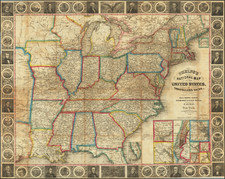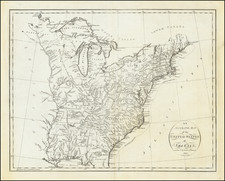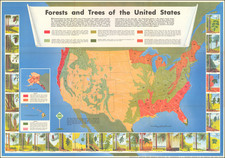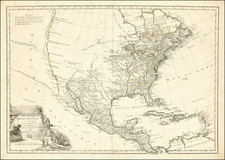This scarce railroad and timetable map showcases the extensive railroad network of the Atchison, Topeka, and Santa Fe Railroad (ATSF) and its leased lines, emphasizing the routes from Kansas to the west, including connections to California and Mexico. The map highlights the primary and connecting railroad lines that were vital for transportation and commerce during the late 19th and early 20th centuries.
The inset map of Kansas provides a closer view, showing the land grant areas awarded to the ATSF Railroad Company. These land grants were critical in financing and promoting the expansion of the railroad, facilitating settlement, and boosting economic development in the region. The main map extends across the United States, illustrating the significant reach of the ATSF network.
The railroad routes extend from Kansas through several key states and territories, connecting to major destinations such as:
- San Francisco, California
- Los Angeles, California
- San Diego, California
- Guaymas, Mexico
The ATSF railroad network, shown in bold lines, traverses through diverse terrains and significant cities, indicating the importance of these routes in linking the central United States to the western coast and parts of Mexico. This connectivity played a crucial role in the movement of goods, people, and services across vast distances, contributing to the economic growth and development of the regions it served.
Additionally, the map details the connecting lines operated by other railroad companies that interlinked with the ATSF, creating a comprehensive and integrated rail system. This integration allowed for seamless travel and transport across the country, enhancing the efficiency of the rail network.
Rand McNally & Co. is a large American map and navigation company best known for its annual atlases. The company got its start in 1856, when William Rand opened a print shop in Chicago. He was joined in 1858 by a new employee, Andrew McNally. Together, the men established their namesake company in 1868. Originally, the company was intended to print the tickets and timetables for the trains running to and through Chicago; their first railway guide was published in 1869.
By 1870, they had shifted from just printing to publishing directories, travel guides, and newspapers. Their first map appeared in 1872 in a railway guide. The map was produced using a new wax engraving method, a cheaper process that gave the company an edge.
By 1880 Rand McNally had entered the education market with globes, wall maps, and geography texts for students. In 1923, Rand McNally published the first Goode’s World Atlas, named after its editor, Dr. J. Paul Goode. For generations afterward, this would be the standard classroom atlas.
In 1899, William Rand left the company, but McNally and his family remained, controlling the company for over a century. In 1904, they published their first road map intended for automobiles and by 1907 were publishing Photo-Auto Guides, which combined photography and mapping to help drivers. In 1924, they produced the Auto Chum, a precursor to their famous road atlases. Rand McNally would remain the leader in road maps and atlases throughout the twentieth century.
In 1937, Rand McNally opened its first store in New York City. Ever on the frontier of technology, Rand McNally pioneered the scribing process for printing tickets in 1958 and printed their first full-color road atlas in 1960. Arthur Robinson developed his now-famous projection of Rand McNally in 1969. By the 1980s, the company was exploring digital reproduction and digital databases of maps for truckers. In the 1990s, they lead the charge to develop trip-planning software and websites. Today, most of its products are available online or in a digital format, including maps for tablets and phones.













![[United States]](https://storage.googleapis.com/raremaps/img/small/93852.jpg)
![[Rare First State] Novissima Tabula Regionis Ludovicianae Gallice dictae la Louisiane . . .](https://storage.googleapis.com/raremaps/img/small/72622.jpg)